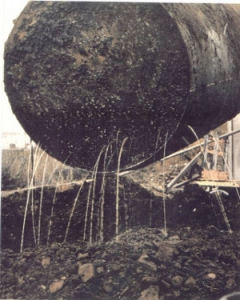Cathodic Protection
IP/APEA Guidance for the Design, Construction, Modification and Maintenance of Petrol Filling Stations:
“…the most effective corrosion protection is provided when high quality coatings and an appropriate cathodic protection system are used in combination”
What is Cathodic Protection?
Cathodic protection is an electrochemical process that can be used to prevent corrosion attacking underground tanks, pipes and structures. In order to understand how cathodic protection works, it is helpful to first understand the corrosion process.
Steel, the most common metal protected by cathodic protection, is produced from iron ore. To produce steel, the iron ore is subjected to a refining process that adds energy. Once the steel is put back into the environment, it begins to revert back to its original state (i.e. iron ore) by releasing the added energy back into the surrounding environment. This process of dispersing energy is called corrosion.
Cathodic protection electrodes, called anodes, are placed near, and connected to, the structure to be protected (i.e. the cathode). Anodes are typically made from cast iron, graphite, aluminium, zinc or magnesium. A cathodic protection system works by passing an electrical current from the anode to the cathode. This process maintains the energy level on the cathode, thus stopping it from corroding. Instead, the anode corrodes, sacrificing itself to maintain the integrity of the structure.
In order for the electrical current to pass from the anode to the cathode, they both must be in a common environment. Therefore, cathodic protection can only be used to protect structures that are buried in soil, submerged in water or encased in concrete. Structures commonly protected against corrosion by the cathodic protection process include oil and gas pipelines, offshore platforms, above and underground storage tanks, ships, electric power plants, bridges, parking garages, transit systems and water and wastewater treatment equipment
Why use Cathodic Protection?
Permanent
Experience in the US and elsewhere in the world has proved that existing steel tanks can be economically and effectively upgraded with cathodic protection. Once properly applied and maintained, cathodic protection can keep underground steel tank systems, including pipework, joints and fittings, leak free indefinitely at a fraction of the cost for replacement storage tanks.
Approved
The United States Environmental Protection Agency, which has regulated the installation and operation of tanks in the US since the early 1980’s, gives the same regulatory status to an existing underground steel tank system, which is properly upgraded, regardless of its age, to that of a brand new tank.
The application of cathodic protection to prevent external corrosion on new buried steel storage tanks is a well-established technique. It is routinely specified as a method of protecting thousands of LPG vessels in the UK and in several EU countries it is compulsory to prtect buried petrol storage tanks wuth cathodic protection.
Verifiable
Buried tanks (USTs) cannot be inpected once they are buried, but when fitted with cathodic protection they can be monitored, to assess the tank’s corrosion status, the level of cathodic protection applied and the breakdown of the tank coating.


